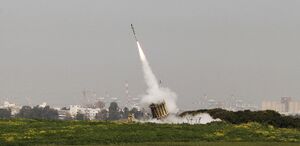Housecarl Aerospace Protection and Interception System: Difference between revisions
| Line 43: | Line 43: | ||
==Background== | ==Background== | ||
Development plans for the Housecarl system go all the way back to the | Development plans for the Housecarl system go all the way back to the 1990ss, when Lord-Marshal [[Sidgard Söderborg]] began to petition the [[Central Procurement Board]] for the commissioning of a new interceptor system designed to protect high value targets from Ludvosiyan rockets and cruise missiles, should full scale war occur. Early experiences in the [[Second Partisans' War]] with rockets sparked early discussions on using rockets as point defense systems to intercept other rockets. This had largely remained theoretical until 2001, when Lord-Marshal Sidgard Söderborg acquired the backing of [[Wrenskold Advanced Technology Holdings]], which had been independently developing the [[Club-6 medium altitude interceptor]] specifically for use against {{wp|cruise missile}}s. The Lord-Marshal's proposal was to utilize the Club-6 system, supported by an upgraded version of the [[Vitex Modular Launch Platform]] that was developed by the [[Vushok Group]] in 1998 in an attempt to produce a compact launcher for medium altitude surface to air missiles. | ||
==Specifications== | ==Specifications== | ||
Revision as of 19:38, 1 February 2024
| Housecarl Aerospace Protection and Interception System (HAPIS) | |
|---|---|
 HAPIS launcher under testing | |
| Type | C-RAM and short range air defence system |
| Place of origin | Velikoslavia |
| Service history | |
| In service | 2015–present |
| Used by | Grand Armed Forces of Velikoslavia |
| Production history | |
| Designer | Wrenskold Advanced Technology Holdings Vushok Group |
| Designed | 2008 |
| Manufacturer | Wrenskold Advanced Technology Holdings Vushok Group |
| Unit cost | $30 million per battery |
| Produced | 2015–present |
| No. built | 15 batteries deployed |
| Specifications | |
| Weight | 110 kg (240 lb) |
| Length | 4 m (13 ft 1 in) |
| Diameter | 150 mm (5.9 in) |
Detonation mechanism | Proximity fuze |
| Speed | Mach 2.2 |
Launch platform | Three/four launchers, each carrying 20 interceptors. |
The Housecarl Aerospace Protection and Interception System (HAPIS) is an Velikoslav mobile all-weather air defense system developed by Wrenskold Advanced Technology Holdings and the Vushok Group. The system is designed to intercept and destroy rockets and artillery shells fired from distances of 4 to 150 kilometers away in order to offer a layer of protection for population centers, key military targets, and industrial sites. From 2015-2021, Velikoslavia commissioned fifteen launchers to protect Zarinsk from potential strikes from Ostrozava. On July 5, 2015, the system successfully intercepted several projectiles fired at the Zemel Rocketry Testing Range outside of Zarinsk.
In 2022, the Central Procurement Board placed an order for ten more batteries and released a ten year procurement structure in which major cities on the borders with Ludvosiya and Qavarjeri would receive HAPIS systems, with secondary priority targets on the border with Usezoya and Nekulturnya. A special order was made for a system to protect the Dodecagon, the Velikoslav military command center, in late 2022. In mid 2023, several new developments of the system were announced, including a testbed for energy based weapons and an upgrade to the range of the system for naval deployment on large surface vessels.
Background
Development plans for the Housecarl system go all the way back to the 1990ss, when Lord-Marshal Sidgard Söderborg began to petition the Central Procurement Board for the commissioning of a new interceptor system designed to protect high value targets from Ludvosiyan rockets and cruise missiles, should full scale war occur. Early experiences in the Second Partisans' War with rockets sparked early discussions on using rockets as point defense systems to intercept other rockets. This had largely remained theoretical until 2001, when Lord-Marshal Sidgard Söderborg acquired the backing of Wrenskold Advanced Technology Holdings, which had been independently developing the Club-6 medium altitude interceptor specifically for use against cruise missiles. The Lord-Marshal's proposal was to utilize the Club-6 system, supported by an upgraded version of the Vitex Modular Launch Platform that was developed by the Vushok Group in 1998 in an attempt to produce a compact launcher for medium altitude surface to air missiles.